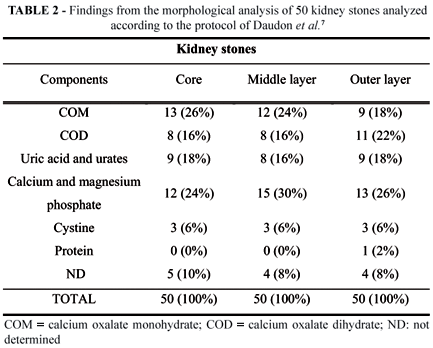Abstracts
PURPOSE: To compare chemical to morphological kidney stone composition analysis based on a sample of 50 stones retrieved from patients at a nephrology service. METHODS: The chemical analysis was performed with a Bioclin® kit, while a 10-mm magnifying glass (10x; Prolabo, Paris, France) was employed in the morphological analysis. Findings obtained with the two methods were compared and classified as concordant (100% agreement), partly concordant (concordant for major components, discordant for minor components) or discordant (discordant for major components). RESULTS: In the chemical analysis, the most commonly observed major component was calcium (70%), followed by oxalate (66%), ammonium (56%), urate (28%) and carbonate (24%). In the morphological analysis, the most commonly observed major components were calcium phosphate and magnesium (32% each), followed by calcium oxalate monohydrate (24%), uric acid and urates (20% each), calcium oxalate dihydrate (18%) and cystine (6%). Infectious kidney stones were identified in 34% and 24% of cases by morphological and chemical analysis, respectively. Thirty-eight percent of the samples were classified as concordant, 52% were partly concordant and 10% were discordant. CONCLUSION: We suggest kidney stones be routinely submitted to both types of analysis for a better understanding of the mechanisms involved in lithogenesis.
Morphology; Urinary Calculi; Urinary Bladder Calculi

 Chemical and morphological analysis of kidney stones: a double-blind comparative study
Chemical and morphological analysis of kidney stones: a double-blind comparative study

